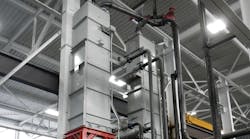The U.S. Occupational Safety and Health Administration has U.S. metalcasters in its crosshairs once again with new measures to enforce and improve compliance with workplace safety standards and reduce worker injuries and illnesses. In September 2022, the agency significantly expanded criteria to its Severe Violator Enforcement Program (SVEP) that includes more substantial consequences for employers that violate OSHA requirements.
Of note, Directive Number CPL 02-00-169 singles out high-emphasis hazards – including silica exposure – as an area where OSHA will be stepping up enforcement through enhanced penalties, mandatory inspections, and public disclosures. In fact, employers on OSHA’s public list of severe violators could now find themselves on that list for at least two years.
And the agency says employers may now be targeted under the SVEP if they are issued at least two willful or repeat violations based on high-gravity serious violations.
OSHA introduced the current first crystalline silica rule in September 2013 and finalized it in March 2016. Exposure to airborne silica in the workplace is a concern for several types of employers, but sand-molding foundries are among those specifically affected by OSHA’s enforcement standards.
The standard aims to protect workers from exposure to respirable crystalline silica, which is a form of silica dust that can cause lung cancer, silicosis and other lung diseases. This standard dictates that employers must ensure that no employee is exposed to an airborne concentration of respirable crystalline silica that exceeds 50 micrograms per cubic meter (μg/m3), calculated as an eight-hour time-weighted average.
For metalcasters, managing the spread of respirable crystalline silica – particles at least 100 times smaller than ordinary sand – is not a new task. Common mitigating tactics found in most U.S. foundries range from ventilator suits and manipulators to shakeout enclosures and baghouse dust collectors.
So why does the issue of complying with health-and-safety regulations (such as personnel exposure to respirable crystalline silica) remain on the radar of many metalcasters?
An American Foundry Society member survey conducted in the fourth quarter of 2022 revealed that more than a quarter of respondents still cite EPA and OSHA regulations are a top concern heading in 2023. In fact, that concern has remained consistent in AFS member surveys conducted over the past 24 months.
By comparison, the Foundry Management & Technology 2023 Metalcasting Outlook survey of foundry and diecasting managers and operators found that a combined 35% of respondents indicated EPA and OSHA regulations represented “significant problems” for their operations in 2022. Nearly 30% of respondents expect this to persist in 2023.
A driving force behind these ongoing concerns is that existing equipment in many foundries are not making it easy for them to meet current regulations.
Vibrating fluid beds, for example, are a common type of technology used to control the temperature of the shakeout foundry sand. Operationally, these machines work by conveying sand on a vibrating and perforated deck. Pressurized air flows upward through the deck to fluidize and cool the sand as it is conducted from one end to the other.
The downside to vibrating fluid beds is they introduce direct contact between the air being used to conduct the heat transfer and the sand product. This highly energetic, blowing air results in silica dusting that escapes from the equipment and contributes to the personnel exposure of respirable crystalline silica in the workplace.
In addition, the large quantity of air required for fluid-bed direct cooling equipment results in dust and emissions that then must be cleaned and scrubbed before being discharged into the atmosphere. Currently, more stringent air quality permits are making expansions or new installations using these direct-contact heat exchangers more challenging to install.
Moving bed heat exchangers (MBHE) are emerging as a preferred solution for metalcasters looking to source a more effective method to dually manage temperature control and silica exposure. The technology indirectly conditions foundry sand through a stacked, vertical-plate design that relies on conduction instead of convection.
Because air is not used in the cooling process and the required heat transfer is realized within a gravity-fed layout, the shakeout sand is not subject to agitation and particle degradation – thereby minimizing dust and subsequent emissions.
In an upcoming report, I will offer more detail about how MBHE technology works and show how this method for controlling foundry sand temperature equips it to better mitigate personnel exposure to respirable crystalline silica.
Scott Harris ([email protected]) is Regional Director, Americas for Solex Thermal Science (www.solexthermal.com), a developer of indirect heat exchange technology for the heating, cooling and drying of free-flowing granular materials.









